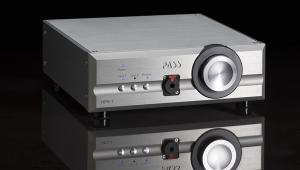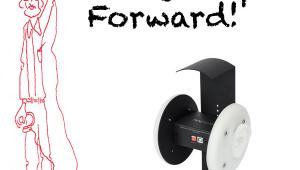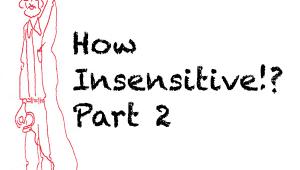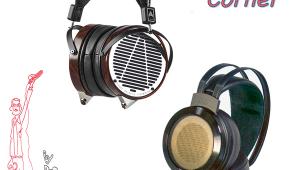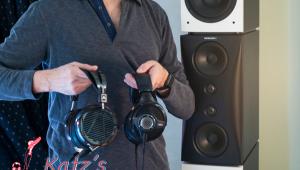| Columns Retired Columns & Blogs |
Katz's Corner: The Great Headphone Shootout. Part 5: The Revisions

This story originally appeared at InnerFidelity.com
EQs, Cabbages, and Kings
So, I purchased the LCD-X. When my new Audeze phones arrived, I immediately discovered they have a bit less bass than the demos I had auditioned and a bit more upper midrange (around 5-7 kHz). In the upper midrange they are a bit more forward and resemble the upper midrange of the 3s that we had tested. In the bottom, they are a little lighter, and I definitely miss some bottom. Basically, the demo unit was more accurate (neutral) than the one I purchased. I bet this is normal unit-to-unit variance, but I hope that the bass will come up upon break-in.
The Stax EQ
It wasn't long before I decided to tweak (the itch that every audiophile gets). I've seen some reports that the Stax 007 MkII (the "Omegas") sound a bit bassy and dull, but I don't have that reaction with the KGSS amp and a superior DAC. My precious Stax is clearly missing something in the bass department and I wanted to see if I could transfuse the slam of the Audeze into the Stax and have the best of both worlds. So I spent a weekend tweaking EQ with DMG audio's excellent digital equalizer Equilibrium inserted into JRiver. I didn't stop until I felt that a tenth of a dB change of any band in any direction made the sound worse, which in this case means "less authentic". Let's take a look at the Stax EQ that I arrived at:
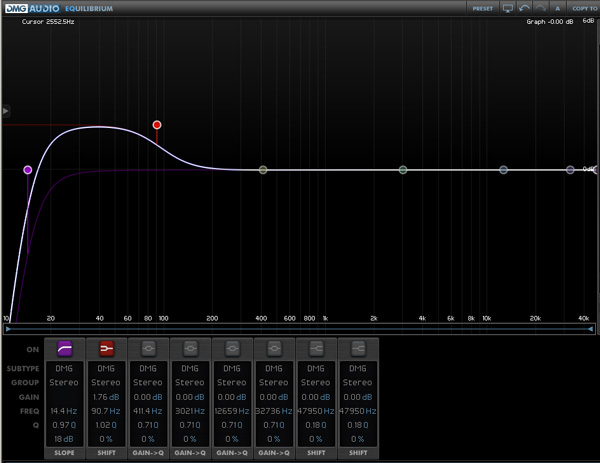
As you can see, it's totally flat from 200 Hz on up, with a gentle low frequency shelving boost starting below 200 Hz, arriving at a little under +2 dB by about 55 Hz. Another important part of the equalizer is the subsonic filter, which some might not desire. But keep the following point in mind:
With headphones, subsonic level (let's say below 25 Hz) is the most subjective judgment. We are simply not built to accept sub bass information (like the thud of a bass drum) located inches from our eardrums. Besides, subsonics with this kind of strong air pressure change could conceivably damage our eardrums—I began to get a headache from strong bass drum thuds without the subsonic filter. Remember my Stax's are modified with the sealed port so they go down low—they exhibit the famous "Stax fart" when putting them on. In contrast, the loudspeakers in my mastering room are flat to below 20 Hz and the subbass sounds exactly right when reproduced from 9 feet away. With loudspeakers we get both the sounds that arrive at the ear and the physical sensation in the chest and body, which become part of the total loudspeaker listening experience. Using Acourate Convolver software, the wavefront from my two JL subwoofers is tight, time-aligned and phase corrected—with effects movies, the low frequencies shake your pants legs!
But that physical experience is missing with headphones and the brain has to adapt to hearing bass energy so close to the ear. Maybe I should put a butt kicker in my chair when listening to headphones! (Ed Note: Take a look at the SubPac, Bob.) So the amount of subsonic level in headphones is quite subjective and with sealed, fast, large diaphragms like the Stax, it's likely we will need a high pass filter. In the case of my Stax this is even more critical, because having sealed up the port, the seal from the surrounding cushions is so tight that air pressure changes in the diaphragm are virtually coupled to your eardrum. All transducers are by nature a highpass filter, but surely very low frequency in the case of the extremely light and responsive Stax diaphragms and a direct-coupled amplifier.
Those of you who have not experienced extreme subsonics have probably been listening to dynamic headphones, which do not appear to extend as low as electrostatics, at least the ones I've experienced. Subsonics can become painful, and this sneaks up on you without realizing it, because the sensation which normally shakes your pants legs is now directly shaking your eardrums, and besides, not translating into much sound perception. Pain is a very bad sign that something is wrong. If you feel pain at any time when using earphones, remove them immediately. Stop listening for that day and make sure you correct the problem for the next day, whether it be from listening too loud, or to those subsonics which nature did not prepare us for.
The DMG Equilibrium can perform linear phase or minimum phase equalization, and in the case of the Stax EQ, I chose minimum phase because it sounded just a hair better. After arriving at my "perfect" EQ, I created a Dirac pulse in Acourate and played the pulse in my Sequoia DAW at each sample rate, capturing it through the EQ. I then transformed the result into filters for use in Acourate Convolver. AC is so versatile that I was able to add the Stax EQ, and later an LCD-X EQ to my digital filters/crossovers and route each filter to a separate DAC destination. I now use 12 channels of DACs! Eight channels for loudspeaker 5.1 with stereo sub bass management, and 4 more for the two separate headphone equalizers. I have four channels left over in my Lynx AES-16 interface so if you have any ideas, let me know :-).
Remember to drop the level when performing any EQ boost, to keep the EQs from overloading. Mine is set to -3 dB. Those of you bit-counters who are afraid of losing resolution with DSP should have no fear, there's so much "footroom" available in properly processed and dithered 24-bit audio that even after processing it still is much quieter than the quietest DAC or preamp. Since Acourate Convolver is a 64 bit floating point DSP, it can do many calculations until the final one, which is a dithered wordlength reduction to 24-bit fixed point to go out to the DACs.
I spent one year carefully comparing, switching back and forth between my old, pure-analog crossover and analog volume control versus Acourate Convolver's digital version before I decided to ditch the analog system. By that time I was certain the Acourate Convolver sounds as pure, deep, big, and transparent as analog processing. That was not the case with other digital correction systems I tried, so it's still true that the devil is in the details.
In a moment I'll tell you how the Stax EQ sounds, but first let's tackle....
The LCD-X EQ
As I mentioned, this sample of phones is a little light in the bass and has a bit of a presence boost circa 7 kHz. I am hoping that break-in will raise the bass, but regardless, this bass boost restored all the heft and punch that I was after.
Here's the LCD-X EQ that I arrived at:
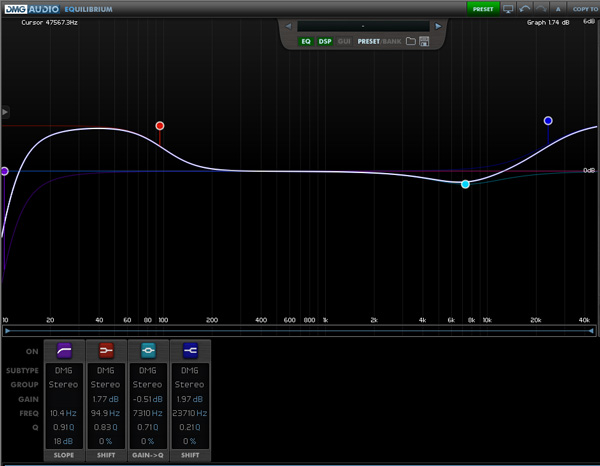
Let's look at the bands from low to high. I debated over it, but I decided to apply a subtle high pass filter to the X's, because their diaphragms are also quite fast and the seal is quite good. The subsonic rolloff I applied is almost inaudible; I still have to experiment with taking this filter in and out. It may protect our delicate eardrums from subsonic pulses that we cannot directly hear. From about 200 Hz on down is our bass boost. Hey, this looks just like the Stax boost. Unfair! Maybe I went too far, but it's hard to be objective, our ears are subject to "psychoacoustic ratcheting" which means that the more you boost, the more you want. Even when you A/B compare against the loudspeakers. So I probably went too far with the Xs.
My good friend Robin Reumers, who was my assistant several years ago, visited the other day and he feels my Stax EQ is a bit too much as well as the X. I disagree about the Stax, but we may only differ by a 1/2 dB. I know Robin's ears very well! The next band is a dip to deal with the unwanted presence boost in my Xs. I don't think I hit the nail on the head with that yet because there is still some sibilant distortion which is not present on the Stax or the loudspeakers.
With the last band I experimented with linear phase and changed to minimum phase. The difference is that linear phase EQ preserves depth but with minimum phase the image moves forward or backward depending on whether you boost or cut. A loudspeaker/earphone is by nature a minimum phase transducer so a complementary equalizer will likely cure its faults. Regardless, since to my ears the X's native response appears to take a nose dive above about 12 kHz, this band is quite subtle and does not make up very much for their lack of air.
The air band of the Stax is still a question in my mind, I'm considering experimenting with a tiny rolloff as there is clearly a rise in the Stax above 1 kHz. Worth playing with just to see what happens. But the Stax inherent rise is so gentle and natural that somehow it sounds pure, extended and open without an obvious brightness, without exagerrating sibilance or being bothersome. So, a high end corrective EQ would have to be very subtle, a few tenths of a dB at most. On the other hand, my old SRD-5's are almost brittle by comparison. Time to play with an EQ for them. Are we having fun yet?
The New Verdict
After the Headphone Slutz meeting I decided to feed the Stax amp with my Forssell MADAC, an excellent performer, and the Burson/LCD-X with a Slim Devices Transporter that I no longer use as a music player, but it has a superb D to A converter. That way I can digitally equalize each headphone separately, all managed within Acourate Convolver. I can switch back and forth between flat or EQ'd with the push of a single button of AC's remote control. This is the proof of the pudding.
The bass boost in the Stax is a winner, it's more solid and it doesn't hurt any of the other ranges. Changing back and forth between phones, the major differences between the Stax and the X's have greatly dissolved. The two phones are much more compatible. This EQ preserves the virtues of each phone while reducing their defects. What was previously two sets of grade A cans is now A+ for sure. Now I can listen to the music on either phone and bathe in its glory without getting itchy.
I can no longer tell you which is my favorite. The corrected Stax still retains the Stax character; it doesn't have the cojones or the punch of the corrected X, but the Stax is now solid and satisfying. At this point the weak link of the X is its air band and I doubt we can do anything about it, unless Audeze themselves can make a lighter, more responsive diaphragm. Or perhaps the lack of air has something to do with the Fazor. Some people don't miss the air at all, but I do. The corrected Stax doesn't have any obvious weak points and it's light as a feather, so I tend to pick that one up for pleasure listening, though tethered by a high voltage cord to a single spot in the house. The two equalized phones are very complementary; when I get the urge for punch, or when I travel around the house with my iPhone, it's X time!
The Punch Line
My theory why the Xs are so much punchier than the Stax is not because of frequency response. I think the slower and heavier diaphragm acts a bit like a bass-frequency compressor, softening and reshaping the transients of the wave just enough to give it strength and power. Magnetic force is non-linear, though Audeze has taken great effort to cancel those non-linearities with a push-pull approach. The electrostatic push-pull design has inherently lower distortion because capacitive force is more linear than magnetic, and the lighter the diaphragm, the easier it is to move and control its movement, to make it stop and go. Like my little Mazda Miata, which can stop on a dime. Objectively, the Stax is probably more accurate in the bass, with the lowest distortion, more accurate than any moving coil transducer, including most loudspeakers. But I think we crave some distortion: The Audeze cans are so seductive and likeable! When does high fidelity cross over into a matter of taste? "Objectively correct" has not always sounded "subjectively correct".
Consider both of these EQs to be works in progress. Very mature, though. If you would like to try something like this, don't take my settings as gospel, just as general directions and amplitudes you can try.
The Last Word Belongs to The iPhone
Since the X's are so efficient, I decided to plug them into my iPhone 6 with the included 1/4" to 1/8" cable adapter. All the files on my iPhone are 1644 ALAC, so we're a big step past mp3 or AAC. I was quite pleased with what I heard. The subtle upper midrange presence of my Xs is the perfect complement to the lower resolution DAC and material in the iPhone. I didn't even notice a bass weakness. This was instantly the best iPhone headphone experience I've ever had. But mostly it's a proof of performance because how do you expect me to carry around a set of X's? You can't jog or dance with them, either. But at least I can play them all around the house! Here's a photo of Bob traveling and dancing with LCD-X's on my head.

See you next time, whatever adventure comes our way.
- Log in or register to post comments

